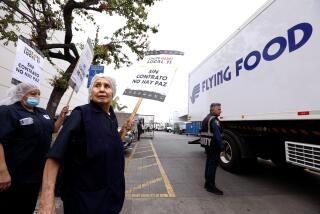Pension Lawsuit Has Wide Implications
- Share via
It’s been 10 years since the failure of Pan American World Airways, and former Pan Am mechanic Richard Brooks still is in court, fighting the government to get all of the retirement pay he believes he’s owed.
The sum isn’t inconsiderable--his monthly $231 pension check is less than half what Brooks thinks it should be--and neither are the implications of his lawsuit, which could affect the fortunes of 40,000 former Pan Am workers.
More important, it has implications for all workers who toil for companies with troubled pension plans--a number that’s likely to increase if the nation’s economic woes worsen.
Brooks’ case underscores the need for vigilance by the 42 million Americans covered by defined-benefit pensions, which pledge to pay retirees a set amount each month until they die. (In contrast, the increasingly common defined-contribution plans--such as 401(k)s--make no such promise.)
“Defined-benefit plans tend to make people feel much more secure, but as this case demonstrates, participants still need to be vigilant--both about how well-funded the plan is and about which of their benefits are insured,” said Karen Ferguson, executive director of the Pension Rights Center in Washington.
Because the U.S. economy is slowing and stock prices have fallen, many experts believe pension failures--which have been modest in recent years--could pick up. That makes Brooks’ battle of interest to anyone who works for a struggling company that provides a defined-benefit plan.
It’s too soon to tell just how the economic slowdown will play out, but “any sustained period of the market conditions that we’ve been experiencing over the last six months would increase the number of [failed pension plans],” said James Delaplane, vice president of retirement services at the American Benefits Council.
Brooks’ story is complex, but it boils down to just one word: “fiduciary”--legal-speak for a person or company entrusted with holding and investing assets for another person.
Brooks, 57, maintains that the Pension Benefit Guaranty Corp., a government agency that insures the pensions of failed companies, becomes a fiduciary when it takes over a failed pension plan. The PBGC is fighting mightily to say that it does not--at least when it comes to determining a retiree’s pension benefits.
When determining benefits, the agency says, it’s a “guarantor” or insurer, not a fiduciary. A federal court in New York has ruled otherwise, but the PBGC is appealing.
Both sides--the Pan Am retirees and the government have been willing to engage in a costly, decade-long battle over this technical issue because the term fiduciary brings with it a serious duty: Fiduciaries must act in the best interest of plan participants.
And in the arcane world of defined-benefit pensions, that makes all the difference, experts say.
Pension documents often are confusing and subject to many interpretations, said Harvey Katz, an attorney with Berlack, Israels & Liberman in New York, who represents Brooks and a group of other Pan Am employees in their long-standing class-action suit. When there’s a judgment call, a fiduciary must take the side that gives the participant the best deal, he added. A nonfiduciary--or “guarantor”--does not.
“The PBGC operates like an insurance company,” Katz said. “Like any good insurance company, they want to take in more than they pay out, which means they’re aggressive in collecting money from companies that have gone bankrupt and parsimonious in what they pay out to beneficiaries.
“If they were forced to act like a fiduciary, they couldn’t be parsimonious. When there was a judgment call, they would have to decide in favor of the participant.”
Pan Am, one of three airlines to file for bankruptcy protection in 1991, abruptly shut down when a last-ditch bailout fell through. Efforts to revive the carrier during the 1990s failed.
The big judgment call in the Pan Am pension case had to do with early retirement benefits. When the PBGC took over Pan Am’s pension plan in 1991, the agency decided workers who were not yet 55 couldn’t get the full benefits Pan Am had promised. Katz maintains the agency would have decided otherwise had it been forced to act as a fiduciary.
Attorneys for the PBGC say the agency’s actions have been “appropriate and lawful” and that all Pan Am workers got the benefits to which they were entitled.
Nonetheless, pension experts agree that if the PBGC is ultimately ruled a fiduciary, it will be held to a higher standard--not only in the Pan Am case but in any case it handles. That would mean that some of the agency’s standard practices would have to change.
Why? Normally, a retiree who is covered by a defined-benefit pension gets a letter shortly after retirement specifying his or her monthly pension benefits. If the retiree believes the amount is wrong, he or she can appeal. The company must respond in a timely fashion with an accounting of how the benefit was determined.
When the PBGC takes over a pension plan, its priority is paying immediate benefits to retirees. Telling the retired workers how much is due them often is postponed while the agency finds and attempts to interpret often-confusing plan documents.
In the meantime, retirees are paid “estimated benefits.” If a retiree thinks that estimate is wrong, he or she is stuck. There is no appeal until the agency makes a formal pension decision, which is conveyed in a document called an initial determination letter.
In the Pan Am case, many retirees didn’t get initial determination letters until seven to 10 years after they had retired--meaning they had to wait that long before they could challenge what they thought were inadequate pension payments.
“These are retirees,” Katz said. A 60-year-old who must wait a decade for a pension determination might die before it’s settled, he said. “It’s the old saying: Justice delayed is justice denied.”
Despite the fact that the suit is on hold while the PBGC appeals, Brooks has had some effect. PBGC officials now say they’re getting initial determination letters out within three years--still a long time, but a big improvement.
Also, a congressional inquiry spurred by Brooks’ suit resulted in several procedural changes intended to make the agency more responsive and efficient.
Still, the key will be whether the agency is forced to adhere to the higher standard of fiduciary responsibility.
As the agency said in a legal memo: “Different standards of conduct and different standards of judicial review apply depending on whether PBGC undertakes the duty as a fiduciary or as the federal guarantor.”
Brooks is confident about his chances of winning, but in retrospect, he wishes he’d acted more quickly when he learned that Pan Am’s pension plan was underfunded and when he first started hearing complaints about how the PBGC was paying benefits.
Companies now are required to send notices to workers if their pension plan doesn’t have enough assets to pay all estimated future claims, said Ferguson of the Pension Rights Center. Workers who get such notices should read them carefully, ask questions and push their firms to fix the problem before it’s too late.
Failing that, they should become educated about what benefits the PBGC will and won’t cover so they won’t be unpleasantly surprised.
“The interesting thing is how Pan Am’s plan got so underfunded,” Brooks said. “They got six waivers of minimum-funding requirements over a period of 12 years. Even when they failed, we thought, ‘It’s OK. The PBGC will take care of us.’
“It took a long time to realize that something was seriously wrong.”
*
Send letters to Kathy M. Kristof, Personal Finance, Business Section, Los Angeles Times, 202 W. 1st St., Los Angeles, CA 90012, or e-mail kathy.kristof@latimes.com.
More to Read
Inside the business of entertainment
The Wide Shot brings you news, analysis and insights on everything from streaming wars to production — and what it all means for the future.
You may occasionally receive promotional content from the Los Angeles Times.










